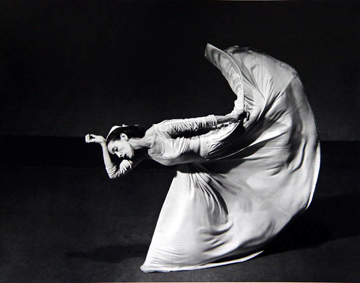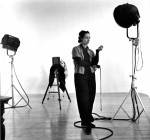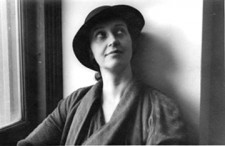
Barbara Morgan
American, 1900-1992
Letter to the World (Kick), 1940
silver gelatin print
SBMA, Gift of Arthur and Yolanda Steinman
1983.69.112

Barbara Morgan in Her Studio, Photographed by Lloyd Morgan
"Light is the shape and play of my thought....my reason for being a photographer." - Barbara Morgan
"A great photograph seems to arrest time. It permits the viewer to be ‘born to the instant’—the Now. In a great photograph the image is never static, whether it be a leaf, a child’s head, a dancer in motion—it is all vibrant with Life.
It permits time for participation through the image which captures that mystery, that—is Life.
This seems to me to be the essential greatness of Barbara Morgan’s photographic images—initial honesty, tireless skill,
and reverence for life makes her essential greatness." - Martha Graham
RESEARCH PAPER
In 1906, when Barbara Morgan was six years old, she recalls her father saying that “everything in the world is made of atoms and all the atoms are dancing.” These words slept in her soul until twenty-two years later when she first saw the Native American Kachina dancers perform. They were reiterated at that moment and would forever light her imagination. Although her artistic pathway emerged early, taking her to UCLA in 1919 where she earned her degree in art and taught in the Art department, it wasn’t until she married the free-lance photographer Willard Morgan in 1925 that she took a serious look at photography. She remained committed to the idea that photography was primarily effective in representing the self-evident record, although her husband consistently urged her to accept his belief that it would become “the Art” of the twentieth century. Three years later, his words rang with new meaning when, as the Curator of Photography at UCLA, she hung a show of a then unknown photographer named Edward Weston who believed in the potential reach of the camera into the heart of the subject. Weston, like Willard Morgan, saw photography as an emerging art form, allowing the eye of the artist to penetrate exterior representations. These early influences were in place when she traveled with her husband to the American Southwest and was captivated by the movements of Native American dance. Her career as a photographer spanned the next fifty years, bringing her honor and distinction including a fellowship at the Philadelphia Museum of Art, a National Endowment of the Arts Grant, a Lifetime Achievement Award and numerous exhibitions in the United States and abroad.
Letter to the World, subtitled Kick, is an exquisite example of Morgan’s artistic concern, as it clearly captures a figurative and emotional essence. She never stopped pushing to new depths, reaching for the creative thrill in the search itself. When she first met Martha Graham in 1935, she realized that photographing dance was an ideal way to record that rhythmic vitality which she found so fascinating. The two women formed a perfect collaboration that was based on mutual artistic and spiritual beliefs, and their association produced a significant body of work. Morgan believed that “previsualization” is the first essential of dance photography. The ecstatic gesture happens swiftly, and is gone. Unless the photographer previsions, in order to fuse dance action, light and space expression, simultaneously, there can be no significant dance picture.” This understanding required both knowledge of the dance content as well as the photogenic message. In preparation for their collaboration in her studio, Morgan and Graham would sit on opposite sides of the room and meditate in the Japanese tradition called Esoragato. Each woman would “become” what she was going to do. They would discuss the themes and imagery of a dance and then begin their work. After observing a dance performance and selecting those particular moments that captured the punch-line of the theme, Morgan would return to her studio with the dancer. She preferred to shoot at a high pitch and develop multiple images as quickly as possible in order to analyze movement while it was fresh. By staging these photographs in her studio, she was ultimately able to capture the most pregnant moments of the dance at their dramatic, visual peak. Calling herself a “kinetic light sculptor,” she continually worked to make patterns of light, middle and dark tones to emphasize the parts and shapes of the body.
Letter to the World is the name of a dance choreographed and performed by Martha Graham in 1940. It was based on a poem by Emily Dickinson of the same title. Morgan captured a series of twenty-one photographs from the performance, with each dancer portraying a different aspect of Dickinson’s personality. The photograph, Letter to the World, speaks both of resistance and resignation. The exquisitely sensitive lighting shows the dramatic and sensuous sweep of the gown so that one truly feels the great swish of the fabric as the dress yields to the relentless thrust of Graham’s kick. The contrast of textures implies yet a deeper aesthetic as we clearly see the bones and contours of the neck and face. A dancer of great power is constrained by the weight and mass of costume just as one’s spirit is confined by decorum and circumstance. The action is geometrically perfect as we can easily sense the mechanical power of those legs which swing like a great metronome to beat time away. The stress is unmistakable as she brings her wrist to her forehead in a gesture of haunting resignation. The incongruity of this powerful kick and the almost off-hand gesture is deeply poignant. Dickinson’s letter to the world came back unanswered, yet the poet’s struggle for personal freedom must always be seen in light of Graham’s magnificent kick.
Barbara Morgan remains a pioneer in photography and an inspiration to her viewers as her work reaches across broad and relevant social issues to those elements of technical virtuosity which elevated and illuminated her abiding interest in rhythm, composition and movement. She constantly sought the limits of human potential and her dance photography pushed these boundaries. One of her major contributions as a photographer of dance was to bridge that gap between a purely representational image and its essential, abstract potential.
Prepared for the Santa Barbara Museum of Art Docent Council by Gretchen Simpson, 2006
FOOTNOTES
Barbara Morgan, ed., Barbara Morgan (New York: Morgan and Morgan, 1972), 128.
2 Graham graduated from Santa Barbara High School in 1913.
3 Morgan
4 Curtis Carter, “Barbara Morgan: Photographer of Dance,” Printed in the exhibition catalogue Faces of Modern Dance: Barbara Morgan Photographs (Milwaukee: Haggerty Museum of Art, 2004)
5 Carter
6 “This is My Letter to the World” 1924
This is my letter to the world,
That never wrote to me,--
The simple news that Nature told,
With tender majesty.
Her message is committed
To hands I cannot see;
For love of her, sweet countrymen,
Judge tenderly of me!”
BIBLIOGRAPHY
Carter, Curtis. “Barbara Morgan: Photographer of Dance.” Printed in exhibition catalogue Faces of Modern Dance: Barbara Morgan Photographs. Milwaukee: Haggerty Museum of Art, 2004
Morgan, Barbara. Martha Graham: Sixteen Dances in Photographs. New York: Morgan and Morgan, 1980.
Morgan, Barbara, ed. Barbara Morgan. New York: Morgan and Morgan, 1972.

Self-Portrait
